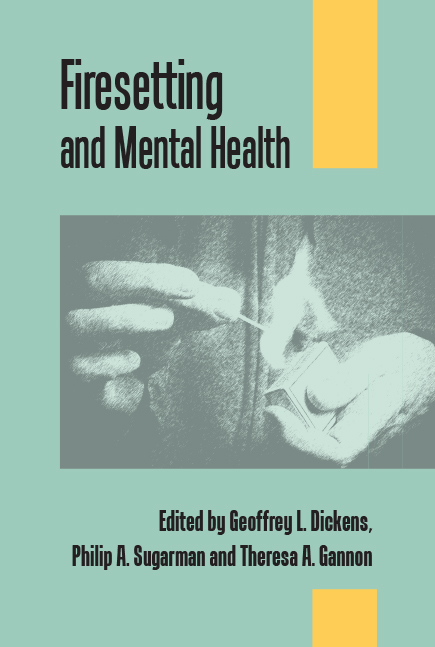Book contents
- Frontmatter
- Contents
- List of figures, tables and boxes
- List of contributors
- Preface
- Part I Theory and research
- 1 Adult firesetters: prevalence, characteristics and psychopathology
- 2 Theories on arson: the action systems model
- 3 Differentiating firesetters: lessons from the literature on motivation and dangerousness
- 4 The potential relevance of brain dysfunction in arson
- 5 The developmental aspects of firesetting
- 6 Intellectual disability and arson
- 7 Female arsonists and firesetters
- 8 Power and excitement in arson: the case of firefighter arson
- Part II Practice and law
- Index
3 - Differentiating firesetters: lessons from the literature on motivation and dangerousness
from Part I - Theory and research
- Frontmatter
- Contents
- List of figures, tables and boxes
- List of contributors
- Preface
- Part I Theory and research
- 1 Adult firesetters: prevalence, characteristics and psychopathology
- 2 Theories on arson: the action systems model
- 3 Differentiating firesetters: lessons from the literature on motivation and dangerousness
- 4 The potential relevance of brain dysfunction in arson
- 5 The developmental aspects of firesetting
- 6 Intellectual disability and arson
- 7 Female arsonists and firesetters
- 8 Power and excitement in arson: the case of firefighter arson
- Part II Practice and law
- Index
Summary
This chapter reviews in detail the long history of exploration of firesetters’ motives and underlines the importance of revenge, vandalism and excitement. However, as fire is inherently somewhat unpredictable, research has only recently begun to identify the centrality of firesetting behaviour in the prediction of future firesetting risk. The courts rightly value the identification of recklessness and intention to endanger life, and look to mental health professionals for guidance. We conclude that the future direction of clinical assessment and research should centre on behaviour, intention and the prediction of risk.
It has long been established that the typical firesetter is young and male (e.g., Lewis & Yarnell, 1951), but in reality firesetters are a heterogeneous group who cut across categories of gender, age and intellectual ability. The characteristics of these groups (men and women, juveniles and adults, those with and without intellectual disability) are worth detailed, individual attention to identify different approaches to risk assessment and treatment. The advantage of such groupings is that they emerge from naturally occurring dichotomies and require little conceptual elucidation. Historically, however, research has not followed this approach. A favoured approach to firesetter differentiation, one that drove a considerable amount of enquiry from the 1970s to the 1990s, has been motivational typing. Motivation can be defined as: ‘the driving force or forces responsible for the initiation, persistence, direction and vigour of goal directed behaviour’ (Colman, 2009). More recently, motivational classification has been viewed as flawed (Prins, 1994; Gannon & Pina, 2010), primarily because clear motives (such as revenge) are often confused with characteristics (such as institutionalisation), but also because entirely different cases of firesetting, such as fires endangering and not endangering life, can be conflated under one heading, such as revenge (Soothill, 1990).
This chapter critiques the chequered history of motivational classification, before examining firesetting behaviour through a prism of forensic risk. We seek to examine what the literature on firesetting recidivism and destructiveness can tell us about identification of the most dangerous firesetters. Throughout, we use the term ‘firesetting’, but when talking about individual studies of people convicted for their intentional firesetting behaviour or when referring to legal issues, we use the term ‘arson’.
- Type
- Chapter
- Information
- Firesetting and Mental Health , pp. 48 - 67Publisher: Royal College of PsychiatristsFirst published in: 2017



